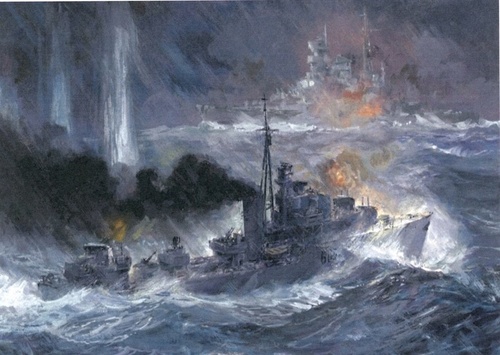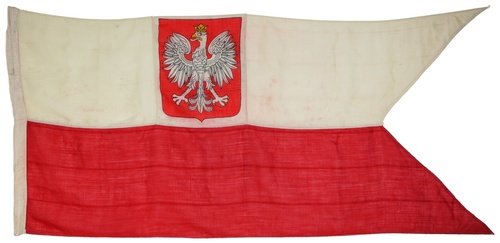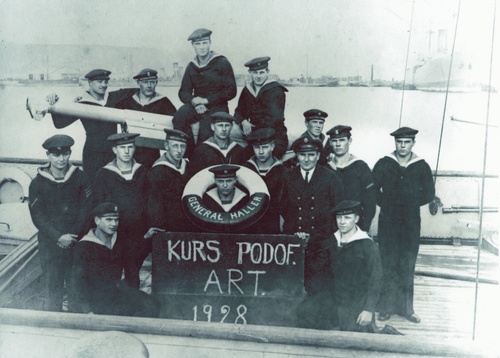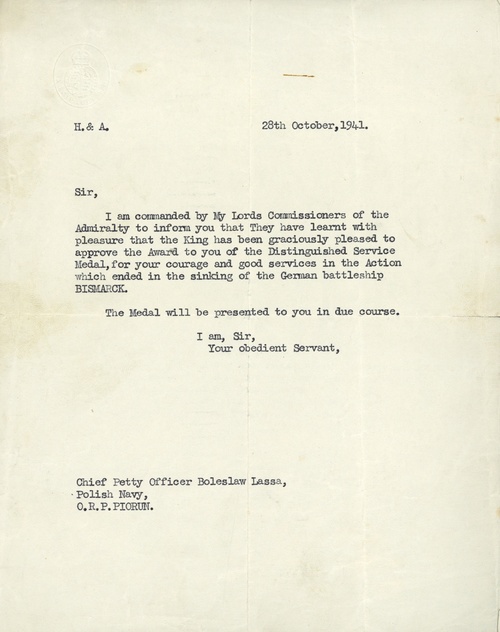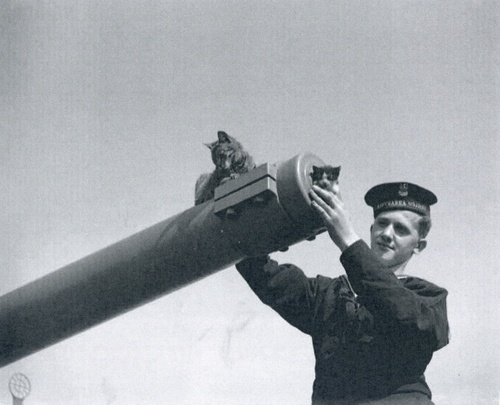Auction: 20001 - Orders, Decorations and Medals - conducted behind closed doors
Lot: 643
Sold by Order of the Family:
A rare and outstanding Second World War 'Sinking of the Bismarck' D.S.M. group of twelve awarded to Chief Petty Officer B. Lassa, Free Polish Navy, who served aboard the O.R.P. Piorun which 'wanted to take on the battleship single-handed' in a David vs. Goliath encounter of monumental proportions
Twice sunk by Luftwaffe bombs and GNAT torpedo - which included surviving the sinking of the Grom at Narvik - Lassa served as Gunner aboard the Piorun during the Clydeside Blitz and valiantly fought off the attention of repeated armadas of enemy aircraft, winning the fond affection and respect of the people of Glasgow - where he ultimately settled in his post-war years
The Polish Awards comprising: Cross of Valour, with Second Award Bar; Cross of Merit, First Class, silver and enamel by Spink, London; Cross of Merit, 3rd Class, with swords; Navy Active Service Medal; Cross of Valour for the Campaign of September 1939, mounted as worn by Spink & Son Ltd.
The British Awards comprising: Distinguished Service Medal, G.VI.R. (Ch. P. O. Boleslaw Lassa. Polish Navy O.R.P. Piorun.); 1939-45 Star; Atlantic Star; copy Arctic Star; Africa Star; War Medal 1939-45, mounted as worn by Spink & Son Ltd., minor contact marks, very fine, together with the recipient’s Arctic Star in its named box of issue (13)
Admiralty Fleet Order No. 843 - Awards to officers and men of the Polish Navy:
'The King has lately been graciously pleased to approve the following awards to officers and men of the Polish Navy for their good services in the sinking of the 'Bismarck':-
Distinguished Service Medal to Chief Petty Officer Boleslaw Lassa, O.R.P. 'Piorun'.
In keeping with practice, the award was not gazetted.
26 D.S.M.’s to the Free Polish Navy for the Second World War and one of just four Awards to the Free Polish Navy for the sinking of the Bismarck, comprising two D.S.C.s and two D.S.M.s.
Boleslaw Lassa was born on 17 October 1907 at Bromberg, which formed part of the Grand Duchy of Posen - formerly the Kingdom of Prussia - and had been part of the German Empire since 1871. Located in the historical region of Kuyavia, between the Brda and Vistula rivers, the city in 1910 was home to 57,700 people, 84% of whom were German settlers, the remainder - including Lassa and his family - consisting of indigenous Poles, all holding German citizenships.
As a consequence of the 1919 Treaty of Versailles, Bromberg witnessed a smooth handover from Germany to the recreated Polish State, and was renamed Bydgoszcz under the Poznan Voivodeship. Lassa took the opportunity to enlist in the Polish Navy on 11 May 1927 and initially served as Gunner aboard the training ship O.R.P. Nurek. He joined at a time of great ambition for the Polish Navy, when the token naval force of four trawlers and two monitors inherited from the Kaiserliche Marine were replaced with a number of modern ships built in France, the Netherlands and the United Kingdom. Notwithstanding the financial squeeze of the Great Depression, the Polish Navy witnessed a considerable modernisation programme under the leadership of Counter-Admiral Jozef Unrug and Vice-Admiral Jerzy Swirski and it was their vision which resulted in the construction of the new ports of Gdynia and Hel along a limited shoreline which had been previously devoid of any substantial haven for shipping.
Their reasoning was clear and simple; the Polish Navy would aim to secure the Baltic lines of supply in the event of war with Russia and would be able to harass and indirectly engage the numerically superior German fleet through the execution of the Peking Plan, whereupon most Polish vessels would automatically withdraw to British ports from where they could secure convoys with aid for Poland - either bound for Gdynia or via Constanta on the shores of the Black Sea in south-eastern Romania.
Transferred to the escort vessel General Haller on 31 August 1928, followed by the torpedo boat Kajawiak and the destroyer Wicher, Lassa witnessed at the turn of the decade the evolution of a small, modern, agile and specialised Polish Navy. Rather than focus upon 'big gun' warships - which were beyond the financial means of the Wladyslaw Grabski government - Lassa trained on fast-moving vessels equipped with 130mm guns, torpedo tubes and depth charges. In November 1936 he was sent to the torpedo boat Mazur and in November 1937 he was transferred as Gunner to the British-built destroyer Grom; it was aboard this vessel that he was able to escape the impending German blitzkrieg and reach the safety of British waters.
"Execute Peking!"
On 29 August 1939, three Polish destroyers under Kommandors Kodrebski, Nahorski and Hulewicz received the signal "Peking, Peking, Peking," from the Polish Commander-in-Chief, Marshal Edward Smigly-Rydz. They immediately weighed anchor and proceeded north-west at full speed towards Norway, passing through the Kattegat and Skagerrak, and entering the North Sea just as news began to filter through across the airwaves of the German invasion of their homeland.
Aboard the O.R.P. Grom ('Thunderbolt' in English), Lassa and his fellow crewmen were met in the North Sea by the British destroyers Wanderer and Wallace, and successfully escorted through the Firth of Forth to Leith docks, then on to the Naval Dockyard at Rosyth. They were accompanied by the Grom's sister ship, the Polish destroyer O.R.P. Blyskawica ('Lightning'), and the French-built destroyer O.R.P. Burza ('Thunderstorm').
Although controversial at the time, the Peking Plan proved a wise decision. The Battle of Danzig Bay on 1 September 1939 gave the Polish navy a foretaste of German aerial superiority and within a handful of days all the other surface ships of the Baltic Navy which remained in home waters had been engaged and sunk or captured by enemy forces (Poland's Navy, 1918-45, by Michael Alfred Peszke, refers). Most telling was the fate of the Polish minelayer Gryf, which lost its Captain and 22 sailors during an engagement with thirty three Ju87 dive bombers, and was later sunk as it sought refuge in the harbour of the Hel Naval Base during a second aerial assault.
The sheer pace of the German blitzkrieg and the division of Poland by the German and Soviet governments meant that no convoys were ever deployed by the Allies to assist with the Polish defensive war strategy. As a result, the three Polish destroyers were deployed in support of Allied maritime operations, in particular the Norwegian Campaign from 9 April-10 June 1940.
Sunk in the Fjords
According to author Hermann Laugs in Kampf um die Erzbahn als Seeoffizier vor Narvik, the O.R.P. Grom was ranked by the German soldiers stationed along the Norwegian coastline as 'the most hated of all the Allied ships deployed in the area'. This hatred was founded on the fact that Grom took an intense interest in all hostile movements on shore and was reputed to spend hours lurking in order to harass German forces. Lassa was surely heavily engaged upon many of her naval gunfire support missions in the Narvik area and around the Rombaken and Vest Fjords but on 4 May 1940 his luck wavered; attacked by three He III bomber aircraft from Kampfgeschwader 100, including one piloted by Lieutenant Gerd Korthals (Chronology of the War at Sea, 1939-45, J. Rohwer, refers), Grom was struck by two bombs from a stick of six and was sunk by an internal explosion caused by the detonation of a loaded torpedo launcher.
She went down within three minutes taking 59 members of her compliment of 180 with her, including one officer, 25 N.C.O.s and 33 sailors. Having escaped the explosion and jumped overboard into the icy waters, Lassa and the remaining survivors, including 30 injured men, were extremely fortunate to be rescued by the British destroyers Bedouin, Aurora, Enterprise and Faulkner before they either died of hypothermia or attracted the attention of enemy troops ashore, who no doubt would have liked nothing more than to reap their revenge upon the ship's crew. Footage of those events make fine viewing and are available online.
Evacuated across the North Sea to Scotland, Lassa spent two months recuperating before being posted to the destroyer Ouragan ('Hurricane') on 18 July 1940 and then transferred to the N-Class destroyer O.R.P. Piorun on 24 October 1940. Formerly named H.M.S. Nerissa, the Piorun was completed at John Brown & Company on the Clyde and transferred by the British Admiralty to the Polish Navy as a replacement for the Grom on 4 November 1940. Crewed almost entirely by Poles and commanded by Eugeniusz Josef Stanislaw Plawski, she underwent training exercises and patrols off the west coast of Scotland, but faced her first significant test during the defence of Clydebank from 13-15 March 1941 when the docks and civilian areas received the full attention of 260 Luftwaffe bombers.
River of Fire: The Clydebank Blitz
In his book Luftwaffe over Scotland: A history of German air attacks on Scotland, 1939-45, Les Taylor characterised the Clydebank Blitz as 'the most cataclysmic event' in wartime Scotland. Receiving repairs within the John Brown & Company shipyard, the Piorun witnessed a firestorm of incendiary bombs which destroyed Singer's wood yard and badly damaged Rothesay Dock and the furnaces and related industrial infrastructure of William Beardmore & Co. Ltd. Amidst a maelstrom of fire and shrapnel, the Piorun retaliated with her oerlikon and machine-gun armament. The sheer chaos was described recently by Clydebank Blitz survivor John Scanlon, and published in the Daily Record:
'There were so many bangs and thumps. A warden came and told us that we had to get out - the tenement was ablaze. My gran was with us - she had suffered a stroke and was paralysed. The next day there were bodies everywhere. The first time I saw my mum she was walking up and down a line of bodies covered in white sheets. She was lifting the sheets and looking, trying to find me.'
That first night, 14 members of one family were killed. The men, women and children of the Rocks family - everyone from five-month-old Thomas to his grandmother Annie, 54 - died at 78 Jellicoe Street, Dalmuir. As rescue works continued on the shattered streets on 14 March, 200 enemy aircraft returned and for seven and a half hours pummelled the town. The two nights' bombardment resulted in 528 civilian deaths and over 600 persons severely wounded, with a further 48,000 people made homeless - the majority of whom were shipyard workers and their families. The Government were quick to post in the local press, 'It is agreed by all observers that the bearing of the people in Clydebank was beyond praise', but just as importantly, the crew of the Piorun were rightly looked upon by locals as nothing short of heroes, having manned their guns throughout. There remains to this day a memorial to the ship's crew in the town's Solidarity Plaza. Unveiled on 13 March 1994, the dedication to the crew adds:
'Rather than seek shelter, the crew manned their vessel's anti-aircraft guns and put up a tremendous barrage despite the bombs and landmines exploding around them and setting the town ablaze.'
Having survived the encounter, the Piorun was repaired and soon back saving lives when called to the rescue of the S.S. Rajputana which had been torpedoed by U-108 in the Denmark Strait, west of Reykjavik, Iceland, on 13 April 1941. The converted passenger liner sank in a little over an hour with the loss of 42 men, including Commodore C. T. O. Richardson, but a further 283 of her crew were plucked from overcrowded lifeboats by the Legion and the Piorun.
Pursuit of Bismarck
At 2130hrs on 18 May 1941 the German battleship Bismarck and heavy cruiser Prinz Eugen departed Gotenhafen for an anti-shipping raid in the North Atlantic. Joined off Cape Arkona by a small flotilla of destroyers, the Bismarck and her consorts entered Kors Fjord, near Bergen, on 21 May and proceeded to anchor, whereupon they were detected by British reconnaissance aircraft.
With the Bismarck shadowed by the heavy cruisers Suffolk and Norfolk in the Denmark Strait on 23 May 1941, Admiralty attention focussed upon the safeguarding of convoys at sea. At this time there were eleven crossing the North Atlantic, six homeward and five outward-bound, the most important being Troop Convoy WS 8B of five ships which had departed the Clyde the previous day bound for the Middle East, escorted by the heavy cruiser Exeter and the Piorun. They were to be met by Force H - including the battlecruiser Renown - which sailed from Gibraltar at 0200hrs on 24 April and had orders to protect the troopships as they headed southwards.
The loss of H.M.S. Hood at 0605hrs on the morning of 24 May 1941 and the subsequent damage to the Prince of Wales, led the Admiralty to attempt an attack by torpedo-laden Swordfish aircraft the following day. Whilst the attack appears to have failed, the violent manoeuvring of the ship to avoid the torpedoes, together with the heavy firing aboard caused a leak in No.2 boiler room to open up. Following further exchanges from 20,000 yards against Prince of Wales, Bismarck finally managed to give the British the slip at 0306hrs on 25 May 1941; at this juncture the first phase of the pursuit ended and the Piorun entered the fray.
'I am a Pole!'
In the late evening of 26 May 1941, the destroyers Maori, Sikh, Cossack, Zulu and Piorin, under the command of Captain Philip Vian, arrived at the scene and proceeded to request the approximate radar position of Bismarck. As the rain intensified and seas grew, Leading Seaman Edward Dolecki on the bridge of the Piorun was the first to make visual contact with the enemy, just in time to witness the final attack on the Bismarck by two Swordfish aircraft from the aircraft carrier Ark Royal. The encounter - which wrecked the steering gear and jammed the rudders of the German battleship, ultimately sealing her fate - was later described by Petty Officer 1st Class Frank Grams, aboard Piorun:
'Both planes flew very low, almost touching the water, and after releasing their torpedoes banked to port to escape safely along the port side of Bismarck. Only one torpedo was successful and exploded on the starboard edge on the stern. All through this time Piorun was at full speed, closing up for another torpedo attack to fire them whenever the tubes were reloaded.'
At 2242hrs, now safe from air attack, the Bismarck focussed her main 15-inch and secondary armament upon the Piorun and Maori. Two attempts were made by the plucky destroyers to work their way northward of the enemy, but they were soon silhouetted against the north-western horizon making them easy to spot. Under 'unpleasantly accurate' fire, the Maori decided to work round to the south and changed course accordingly, but the Piorun determined to close the range and opened fire from 13,500 yards. Amidst the epitome of an David Vs Goliath showdown, the 1,773 ton Piorun attempted to reach its top speed of 36 knots and speared directly through choppy seas towards its 42,000 ton adversary, the largest warship ever constructed in Germany.
According to one report, Captain Eugeniusz Plawski transmitted to the German ship 'I am a Pole,' before commencing fire on the Bismarck. With their home country under enemy occupation, the Poles were eager to fight back, fully aware that the Piorun's 4.7-inch guns could do little harm to a battleship bedecked with a 220mm-320mm armoured belt. Giving the order to fire in the failing light, Plawski is said to have cried out "Trzy salwy na cze?? Polski!' (Three Salvoes in honour of Poland!) before the Piorun weaved left and right, exchanging fire for over an hour.
The brave attack of the little destroyer against such an overwhelming foe was later described by the Royal Navy Magazine Ditty Box:
'None of the destroyers which attacked Bismarck will ever forget the almost crazy bravery of Piorun, which wanted to take on the battleship single-handed.'
The official Admiralty report after the battle added:
'The conduct of the night operations by these five destroyers was a model of its kind. In heavy weather, frequently under fire, they hung on to their prey with utmost determination, hit her with torpedoes and delivered her (to the Fleet) next morning.'
Despite failing to register any significant damage upon the enemy, it ultimately mattered not whose torpedoes had crippled the Bismarck, but to the Poles it was a matter of honour that one of their vessels took part in the battle and shadowed the enemy until the decisive blows were meted out by the British battleships George V and Rodney on the morning of 27 May 1941. The British fleet closed in and for over an hour proceeded to mercilessly pound what still remained of Bismarck with their heavy guns. Finished off by torpedoes from the Dorsetshire, the sailors aboard the Piorun watched with pride as the fiery hulk sank to the icy depths, taking Vice-Admiral Johann Günter Lütjens with her. As Senior Officer of the German destroyer flotilla which had attacked the Polish destroyer Wicher and assisted with the destruction of the Gryf in the Gulf of Gdansk in September 1939, none aboard the Piorun mourned the loss of the Vice-Admiral.
Only 116 members of the Bismarck's crew survived the final onslaught. Running low on fuel, the Piorun returned home to the Clyde where her crew took time to rest and take stock of events. Remaining aboard her during Convoy WS 10 from the Clyde to the Middle East in August 1941, Lassa was notified of his D.S.M. in October 1941 by the Honours and Awards Office of the Admiralty. He transferred to the O.R.P. Orkan a year later.
'The only thing that really frightened me during the War was the U-Boat peril' - Winston Churchill
Having survived repeated attacks by the Luftwaffe and the attention of one Grand Admiral Erich Raeder's mightiest battleships for over an hour, Lassa's luck miraculously held out once again when the O.R.P. Orkan, formerly H.M.S. Myrmidon, was attacked at 2158hrs on 7 October 1943 by a GNAT homing-torpedo from U-758 under Kapitänleutnant Helmut Manseck, whilst escorting convoy SC 143 across the North Atlantic. The torpedo missed by a matter of feet and detonated in the wake of the Orkan leaving no damage.
The next morning, the U-Boat peril reared its ugly head for a second time when the Orkan attracted the attention of a second U-Boat, the U-378 under the command of Kapitänleutnant Erich Mader, a veteran of four patrols and 149 days at sea. At 0705hrs a second GNAT was launched which hit the Orkan without warning and before any evasive manoeuvres could take place. She sank within minutes taking 179 Polish and 7 British crew members with her, including the commanding officer Hryniewiecki. Flung into the water by the explosion, or forced to abandon ship and cling to wreckage, just one officer and 43 ratings survived, being rescued in the nick of time from hypothermia and exposure by the destroyer H.M.S. Musketeer. Remarkably, once again, Chief Petty Officer Lassa numbered amongst their ranks.
Of the 27 ships which represented the Free Polish Navy during the Second World War - comprising 2 cruisers, 9 destroyers, 5 submarines and 11 torpedo boats - the loss of the Orkan proved the highest loss of life in a single event; indeed of the 4,000 Polish seaman who served during the war, approximately 450 lost their lives in total, over a third of this total aboard the Orkan alone (86 Years of the Polish Navy, refers).
Post-War: President of the Polish Naval Association
The loss of the O.R.P. Orkan marked the end of Lassa's war. He served as Coxswain of the landing craft Messina from 3 October 1946-26 July 1947, and repeated the role aboard the landing craft '4050' from 27 July 1947-18 January 1948, before being discharged from the Polish Resettlement Corps at Witley Camp, Godalming, Surrey, on 23 June 1948, his military conduct noted as 'exemplary'.
Settling at Polwarth Street, Glasgow, Lassa built a life as a service apartment proprietor, married and raised a family, and became a key member of the Polish Naval Association, becoming its President in 1970 and Honorary Chairman thereafter. His former home of Bydgoszcyz was occupied by the advancing Red Army in March 1945 and it is likely that few of the minority indigenous Pole population remained alive, given the brutality of the mass executions by German forces in the Old Town Market Square in 1939 and prolonged persecution during the occupation. Those Germans who remained a further six years - including the family of Wehrmacht General Friedrich August Eberhard von Mackensen, who was born in the city - were finally expelled by the Russians, their property and land confiscated.
Boleslaw Lassa died in Glasgow on 19 June 1976 and is buried at St. Peter's Cemetery, Dalbeth, which bears the Polish Naval Association Memorial.
To be sold with the following original documentation and ephemera:
(i)
A Free Polish Navy Battle Ensign, swallow-tailed cloth with original rope fittings, bearing the Crowned Polish White Eagle, 2000mm x 920mm, in generally very fine condition, with blurred manufacturer's stamp.
By family repute, this is the Battle Ensign flown by the O.R.P. Piorun during the legendary encounter with the battleship Bismarck. It was presented to Petty Officer Boleslaw Lassa by Captain Eugeniusz Plawski upon his award of the Distinguished Service Medal.
(ii)
Original typed letter from the Admiralty, dated 28 October 1941, informing C.P.O. Lassa that he is to be awarded the D.S.M. for his 'courage and good services in the Action which ended in the sinking of the German battleship Bismarck.'
(iii)
Original Army Book 64, 'Soldier's Service and Pay Book', noting that he enlisted at Rosneath for the P.R.C. on 18 February 1947, and completed 1 year and 126 days with the P.R.C.
(iv)
Original Certificate issued by the P.R.C. Record Office, Naval Division, at Witley Camp, Godalming, on 14 August 1948, stating that C.P.O. Boleslaw Lassa 'served in the Polish Navy under the British Command, and during the whole time of his service in the Polish Navy his conduct was exemplary.'
(v)
Certificate of Service at Sea in the Polish Navy, stating the complete service of Lassa, commencing as Gunner aboard the Training Ship O.R.P. Nurek on 11 May 1927, transferring as Gunner to the Escort Vessel General Haller on 31 August 1928, Gunner aboard the Torpedo Boat Kujawiak from 13 February 1929, Gunner aboard the destroyer Wicher from 23 July 1929, Gunner aboard the Destroyer Burza from 18 April 1932, Gunner aboard the Torpedo Boat Mazur from 28 November 1936, Gunner aboard the Destroyer Grom from 21 November 1937, followed by a brief return to the Mazur, Gunner aboard the destroyer Ouragan from 18 July 1940, followed by service aboard the O.R.P. Piorun as Gunner from 24 October 1940; a most thorough service record document, bearing the stamp of the Polish Resettlement Corps Record Office, dated 25 August 1948.
(vi)
Original Naval epaulettes (2) and fabric rank insignia (5), with fabric riband bar, as worn by the recipient.
(vii)
An original envelope addressed from B. Lassa of Stoke Terrace, Devonport, to Mrs Jessie Lassa of 161 Great Western Road, Glasgow.
Subject to 20% VAT on Buyer’s Premium. For more information please view Terms and Conditions for Buyers.
Sold for
£9,000
Starting price
£7000

